Based on follow-up venograms, the rate of thrombus regression plus changes in clinical symptoms were similar in both groups. There was a trend for more thrombus progression with ximelagatran than with dalteparin (8% and 3%, respectively), but this difference was not statistically significant. The rates of bleeding were similar in both treatment groups. Building on this information, a phase III placebo-controlled, blinded trial comparing oral ximelagatran monotherapy (36 mg twice daily) for 6 months with enoxaparin therapy (1 mg/kg subcutaneously twice daily) followed by warfarin therapy (in doses sufficient to produce an INR of 2 to 3) for 6 months has recently been completed. 
A total of 2,489 patients with venous thromboembolism were entered into the trial, with 1,249 randomized to receive ximelagatran and 1,249 randomized to receive enoxaparin followed by warfarin. The primary end point, objectively documented recurrent venous thromboembolism, occurred in 2.1% and 2.0%, respectively, of those randomized to receive ximelagatran or enoxaparin/warfarin, a difference that was not statistically significant. Major bleeding occurred in 1.3% and 2.2% of those patients randomized to receive ximelagatran or enoxaparin/warfarin, respectively, a difference that was not statistically significant. The all-cause mortality rates were 2.3% and 3.4%, respectively, in the ximelagatran and enoxaparin/warfarin groups.
This study suggests that therapy with oral ximelagatran is as effective and safe as conventional anticoagulation therapy with low-molecular-weight heparin followed by warfarin for the initial treatment with Generic viagra australia of patients with venous thromboembolism. Unlike low-molecular-weight heparin, ximelagatran can be given orally, and, in contrast to warfarin, ximelagatran does not require anticoagulation monitoring. Consequently, ximelagatran is more convenient to administer than conventional treatment.
Ximelagatran also has been evaluated for the prevention of recurrent thrombosis in patients with venous thromboembolism. The THRIVE III trial randomized 1,233 patients who had completed a 6-month course of anticoagulant therapy for the treatment of venous thromboembolism to receive ximelagatran (24 mg twice daily) or placebo for an additional 18 months. Recurrent venous thromboembolism, the primary end point, occurred in 12 patients who had been randomized to receive ximelagat-ran and 71 who had been randomized to receive placebo (hazard ratio, 0.16; p < 0.001). Major bleeding occurred in six patients who had been treated with ximelagatran and five patients who had been treated with placebo, and there were no incidents of fatal or intracranial bleeding.
Atrial fibrillation. Ximelagatran has been compared with warfarin in the treatment of patients with nonvalvular atrial fibrillation. In the Stroke Prevention Using Oral Thrombin Inhibition in Atrial Fibrillation (SPORTIF) II trial, 257 patients were randomized to receive one of three doses of ximelagatran (20, 40, or 60 mg twice daily) or warfarin (in doses sufficient to produce an INR of 2.0 to 3.0).